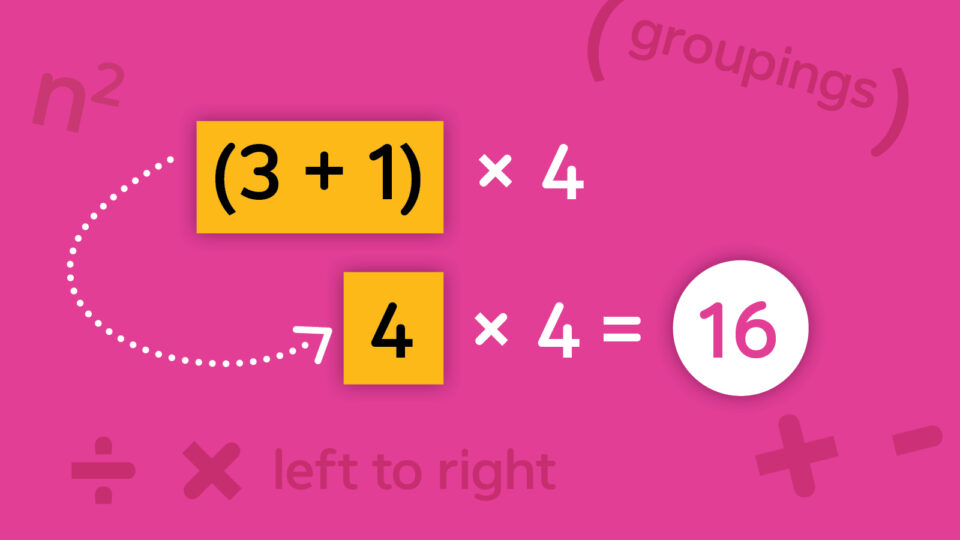
When students in Grades 3 and up initially learn to add, subtract, multiply, divide, and work with basic numerical expressions, they begin by performing operations on two numbers.
\[3+2\]
But what happens when an expression requires multiple operations?
\[9 \div 3 + 2 \times 6\]
Do you add or multiply first? What about multiply or divide? This article explains what order of operations is and gives examples that you can use with students. The article is broadly divided into two lessons, one that introduces the concept and another that develops it. Both lessons pertain to the following common Grade 3 standard: “Perform arithmetic operations involving addition, subtraction, multiplication, and division in the conventional order, whether there are parentheses or not.”
What is the order of operations?
The order of operations is the set of rules used to determine the sequence in which mathematical operations, like addition, subtraction, multiplication, and division, should be performed to ensure consistent results.
This is an example of mathematics that is procedural: rules that you must memorize and follow in order to ensure that your notation is clear and anyone reading your expression or equation will interpret it in the same way. Procedural skills can still be deep, however! “Rules” often come with rationales and exceptions. The order of operations can present difficult problems appropriate even for older students:
- Does the left to right rule change when the multiplication is implied rather than spelled out? (For example, \(3g\) or \(8(12)\) instead of \(3 \times g\) or \(8 \cdot 12\).)
- Where does factorial fall within the order of operations?
- What about exponents? What happens when you have an exponent raised to another exponent, but there are no parentheses? Note: these lessons do not include exponents but can be expanded to include them.
What comes first in order of operations?
Over time, mathematicians have agreed on a set of rules called the order of operations to determine which operation to do first. When an expression only includes the four basic operations, here are the rules:
- Multiply and divide from left to right.
- Add and subtract from left to right.
When simplifying an expression such as \(12 \div 4 + 5 \times 3 - 6\), first compute \(12 \div 4\) since the order of operations requires first evaluating any multiplication and division (whichever comes first) from left to right before evaluating addition or subtraction. In this case, that means first calculating \(12 \div 4\) followed by \(5 \times 3\). Once all multiplication and division have been completed, continue by adding or subtracting (whichever comes first) from left to right. The steps are shown below.
| \(12 \div 4 + 5 \times 3 - 6\) | |
| \(3 + 5 \times 3 - 6\) | Because \(12 \div 4 = 3\) |
| \(3 + 15 - 6\) | Because \(5 \times 3 = 15\) |
| \(18 - 6\) | Because \(3 + 15 = 18\) |
| \(12\) | Because \(18 - 6 = 12\) |
Here’s another expression as an example:
| \(6 + 4 \times 7 - 3\) | |
| \(6 + 28 - 3\) | Because \(4 \times 7 = 28\), which is done first because multiplication and division are evaluated first. |
| \(34 - 3\) | Because \(6 + 28 = 34\) |
| \(31\) | Because \(34 - 3 = 31\) |
Sometimes we might want to ensure addition or subtraction is performed first. Grouping symbols such as parentheses \(( )\), brackets \([ ]\), or braces \(\{ \}\), allow us to determine the order in which particular operations are performed.
The order of operations requires that operations inside grouping symbols are performed before operations outside them. For example, suppose there were parentheses around the expression 6 + 4:
| \((6 + 4) \times 7 - 3\) | |
| \(10 \times 7 - 3\) | Because \(6 + 4 = 10\), which is done first because it’s inside parentheses. |
| \(70 - 3\) | Because \(10 \times 7 = 70\), and there are no more parentheses to consider. |
| \(67\) | Because \(70 - 3 = 67\) |
Notice that the expression has a totally different value from the previous expression, even though they have the same numbers and operations! What if we put parentheses around \(7 - 3\) instead?
| \(6 + 4 \times (7 - 3)\) | |
| \(6 + 4 \times 4\) | This time, \(7 - 3\) is in parentheses, so do that first. |
| \(6 + 16\) | Because \(4 \times 4 = 16\), and once there are no parentheses left, proceed with multiplication before addition. |
| \(22\) | Because \(6 + 16 = 22\) |
This set of parentheses yields yet another value. So, when parentheses are involved, the rules for order of operations are:
- Do operations in parentheses or grouping symbols.
- Multiply and divide from left to right.
- Add and subtract from left to right.
Although exponents are not included in the lesson below, they are typically placed between parentheses and multiplication, division, resulting in the common mnemonic PEMDAS to remember the order of operations: Parentheses, Exponents, Multiplication, Division, Addition, Subtraction. Other variants of this mnemonic exist, often depending on the country, such as BEMDAS (“brackets” instead of “parentheses”) or BOMDAS (“other” instead of “exponents”).
Lesson 1 – Introducing the concept: Order of operations
Before your students use parentheses in math, they need to be clear about the order of operations without parentheses. Start by reviewing the addition and multiplication rules for order of operations, and then show students how parentheses can affect that order.
Materials: Projector, whiteboard, or way to write for the class publicly
Prerequisite skills and concepts: Students should be able to evaluate and discuss addition, subtraction, multiplication, and division expressions.
Ask: What operation do I perform first in the expression \(5 \times 7 + 3\)? Why?
Write the expression publicly. If students disagree, have them explain. If needed, remind them that in the order of operations, multiplication and division come before addition and subtraction.
Ask: What is the value of this expression?
Walk students through evaluating the expression. \(5 \times 7 = 35\), so the expression becomes \(35 + 3\), which equals \(38\).
Ask: What happens if I switch the addition and multiplication symbols? What value would I get?
Rewrite the expression as \(5 + 7 \times 3\), and work through the evaluation. \(7 \times 3 = 21\), so the expression becomes \(5 + 21\), which equals \(26\).
Ask: Did we get different values when we changed the operations?
This result will probably not surprise your students. They likely know that performing different operations on the same numbers will give different values. If time permits and students are ready, challenge them to find an expression where switching the addition and multiplication symbols like you did results in the same value. If any students succeed, have them show how they derived the expressions. Note that it is only possible when the middle number is 1 (e.g. \(5 \times 1 + 3\) or \(5 + 1 \times 3\)) or the outside numbers are equal (e.g. \(3 \times 7 + 3\) or \(3 + 7 \times 3\)).
Ask: What if I wanted to keep the multiplication and addition symbols in the same place (\(5 \times 7 + 3\)) but perform \(7 + 3\) first? How do you think I could do that?
Discuss the question for a short time, then write \(5 \times (7 + 3)\) on the board. Draw attention to the parentheses.
- Say: We call these symbols parentheses. If there are parentheses in an expression, do whatever is inside the parentheses first.
Ask: What is inside the parentheses in the expression \(5 \times (7 + 3)\)?
Make sure that students can correctly identify that \(7 + 3\) is inside the parentheses and that it should be evaluated before computing with the \(5\).
Say: Now, let’s finish calculating the value. (The value is \(5 \times 10\), or \(50\).) Is that the same value we got before?
Help students notice that the value isn’t the same as either the original expression or the expression with the operation symbols switched.
This would be a good moment to discuss the mathematical practice of attending to precision. Part of learning math is paying attention to the tiniest details. A single dot in the wrong place can vastly change mathematical meaning. In math, it is critical to put care into writing mathematical expressions and making mathematical statements. Can you imagine mixing up the rules when calculating medicine dosages or payment plans?
Give students a few more examples, showing an expression with and without parentheses. Have student volunteers evaluate the expressions and compare their values. When students arrive at different values, prompt them to find similarities and differences in their strategies. Guide the discussion so that students can see which strategy matches the rules for order of operations.
Lesson 2 – Developing the concept: Order of operations
Materials: Projector, whiteboard, or way to write for the class publicly
Prerequisite skills and concepts: Students should be familiar with order of operations and feel prepared to practice it.
This lesson adds parentheses and grouping symbols to the order of operations. While teaching, look out for the misconception that parentheses always change the value of an expression. This is often the case, but not always.
Ask: What operation do I perform first in the expression \(3 + 5 \times 8\) and why?
Write the expression publicly. Make sure students understand clearly that the order of operations requires them to perform multiplication before addition.
Ask: What happens if I want to add 3 and 5 before I multiply by 8?
Allow students to discuss ideas of how to override the order of operations. Encourage mathematical discourse, compare differing opinions, and when possible, try to correct misconceptions. Note that there are many possible answers! For example, the problem could be expanded to say “add 3 and 5 first.” Other grouping symbols can be used; in fact, historically, there have been many ways of grouping, such as using horizontal bars over the expression. If they don't mention parentheses, remind them of what you did in the first lesson.
- Say: By putting parentheses around \(3 + 5\) we are saying that we must add 3 and 5 first, then multiply by 8. Today we’re going to practice finding the value of expressions with and without parentheses and see what difference the parentheses make.
Write the following three expressions publicly for all students to see.
\[3 + 6 \times 2\]
\[(3 + 6) \times 2\]
\[3 + (6 \times 2)\]
Say: Calculate all three expressions.
Allow time for students to finish calculating. Then have student volunteers report what they found.
Ask: Did you get the same value for all three expressions? Why or why not?
Students should notice that the first and third expressions yield the same value while second expression is different. Discuss that the second expression requires adding before multiplying, while the other expressions require multiplying before adding. The goal is for students to see that the use of parentheses sometimes changes the value of an expression and sometimes doesn’t.
Write the following two expressions publicly for all students to see.
\[(8 \div 4) - 2\]
\[8 \div (4 - 2)\]
Say: Calculate both expressions.
Allow time for students to finish calculating. Then have student volunteers report what they found.
Ask: Are the values of these expressions the same? Why or why not?
Once again, students should see the significance of the use of parentheses.
Say: Now we are going to try an activity with many possible solutions. Your goal is to find an expression where you can move the parentheses without changing the value. The challenge is the parentheses must be around addition or subtraction.
Walk through an example. Show how in the two expressions below, the parentheses are around an addition expression, and when they’re moved, the expression’s value stays the same: 7.
\[(3 + 4) \times 1\]
\[3 + (4 \times 1)\]
- If feasible, have students work in pairs to create additional examples. For students who are stuck, have them try replacing the 3 and/or 4 in the expressions above.
Ask: How did you create expressions that allowed you to “move” the parentheses? What problems did you run into?
Facilitate a discussion around the different expressions students made. Have students compare similarities and differences both in the expressions they made and the strategies they used to make them.
Wrap-up and assessment hints
It is important that students can remember the rules for order of operations both with and without parentheses. Avoid giving worksheets of rote practice. Instead, look for math problems that naturally result in expressions that need to be evaluated, for example substituting values into a formula, and have students practice order of operations in the context of other problems.
***
This blog post, originally published in 2021, has been updated for 2025.
Looking to grow student confidence in mathematics, beyond practicing the math rules of order of operations? Explore HMH Into Math, our K–8 core mathematics solution.
Get our FREE guide “Optimizing the Math Classroom: 6 Best Practices.”












